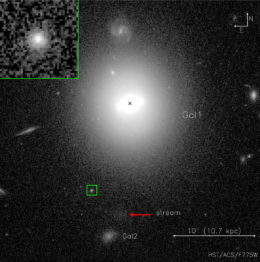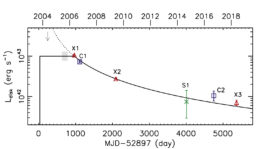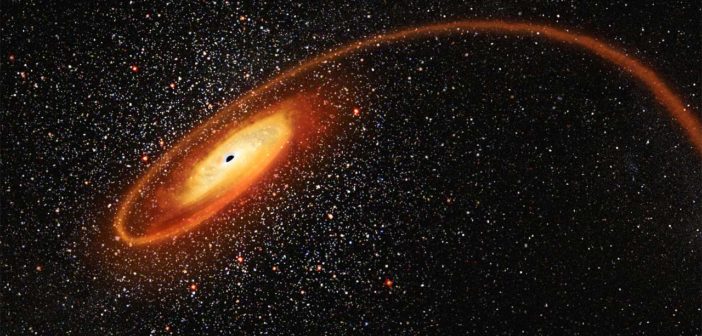We’ve searched for decades for concrete evidence of intermediate-mass black holes, black holes with masses between 100 and 100,000 times that of the Sun. In spite of our best efforts, these monsters have remained elusive — but a new study provides some hope.
Searching for the Middle Sibling

Illustrations of two types of accreting black holes: a stellar-mass black hole accreting from a binary companion (top) and a supermassive black hole accreting gas in a galaxy’s center (bottom). [Top: ESA/NASA/Felix Mirabel; Bottom: ESO/M. Kornmesser]
But what about the range in between? Theory predicts that intermediate-mass black holes should be the building blocks for larger supermassive black holes, but we’ve yet to find concrete evidence for a black hole with a mass between 100 and 100,000 solar masses.
To Weigh a Black Hole
We have, however, found candidates! A number of observational clues have pointed to hidden middleweight black holes lurking both inside and outside of our own galaxy. Unfortunately, confirming these candidates is challenging, since there’s no simple means to weigh these black holes.
Our best bet for confirmation is to rule out alternative explanations. This is the approach taken by a team of scientists led by Dacheng Lin (University of New Hampshire) in the case of intermediate-mass black hole candidate 3XMM J215022.4−055108.

New Hubble image of the environment around J2150–0551. The source is located in the outskirts of a distant lenticular galaxy; J2150–0551 is outlined here with a green box and a zoomed-in view is shown in the inset. [Lin et al. 2020]
A Promising Candidate
3XMM J215022.4−055108 (J2150–0551 for short) is a source visible in both X-rays and optical light. Recently, J2150–0551 exhibited a 12-year-long X-ray outburst — and the the leading explanation for this temper tantrum is that we’re seeing a normally invisible intermediate-mass black hole that’s indulging in a snack. In this picture, the X-ray outburst is due to the tidal disruption of a passing star and the subsequent accretion of the star’s material onto the black hole.
The catch? The outburst could also be explained by a source closer to home: the cooling crust of a galactic neutron star that was heated in a large outburst of accretion. So how can we rule out an ordinary, nearby neutron star and confirm the theory that J2150–0551 is instead a distant intermediate-mass black hole?
Evidence in Favor
Lin and collaborators look to new observations of J2150–0551, both in optical light with the Hubble Space Telescope and in X-rays with XMM-Newton. From these data, they confirm two important points:
- The optical light coincident with J2150–0551 is not a point source.
If this were a galactic neutron star, we’d expect to see a point source; instead, the optical counterpart is an extended source consistent with a star cluster of about 10 million solar masses in the outskirts of a distant galaxy. Such a star cluster would be the perfect size to host an intermediate-mass black hole at its center. - The light curve has continued to decay over the past 12 years.

The decay of the light curve for J2150–0551 is well fit by a simple tidal disruption event model over 12 years of data. Click to enlarge. [Adapted from Lin et al. 2020]
This decay is beautifully fit by a simple tidal disruption event model.
Together, these observations and careful modeling strongly support a picture in which a 50,000 solar-mass black hole lit up after disrupting a small main-sequence star — providing some of the most compelling evidence yet for the existence of an elusive intermediate-mass black hole.
Citation
“Multiwavelength Follow-up of the Hyperluminous Intermediate-mass Black Hole Candidate 3XMM J215022.4−055108,” Dacheng Lin et al 2020 ApJL 892 L25. doi:10.3847/2041-8213/ab745b
